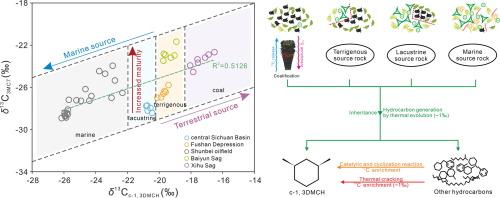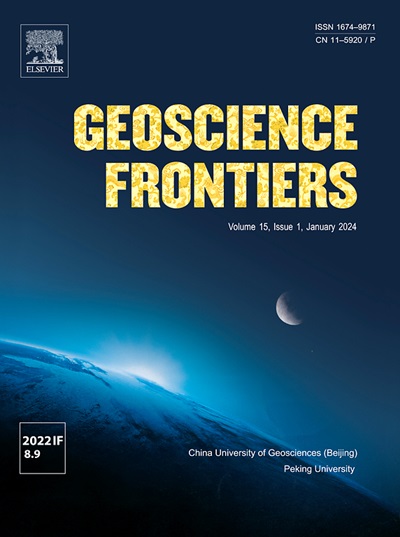Stable carbon isotope compositions of individual light hydrocarbons in oils: New indicator of source facies and maturity
IF 8.9
1区 地球科学
Q1 GEOSCIENCES, MULTIDISCIPLINARY
引用次数: 0
Abstract
Light hydrocarbons (LHs) are key components of petroleum, and the carbon isotopes composition (δ13C) of individual LHs contains a wealth of geochemical information. Forty-four oil samples from five different basins were analyzed using gas chromatography (GC), gas chromatography-mass spectrometry (GC–MS), and gas chromatography-isotope ratio mass spectrometry (GC-IRMS). The δ13C values of forty-three LHs were recognized and determined by comparing the GC and GC-IRMS methods. The results revealed significant differences in δ13C distribution characteristics among different LH compounds. The δ13C variation of individual LHs in iso-paraffins showed the widest range, followed by cycloalkanes and aromatics, whereas the δ13C variation in n-paraffins showed the narrowest range. The δ13C values of most individual LHs are primarily affected by the source facies and thermal evolution. Among them, c-1, 3-dimethylcyclohexane (c-1, 3DMCH) is mainly sourced from higher plants but may also form through abiotic mechanisms such as catalysis or cyclization. The δ13C values of c-1, 3DMCH (δ13Cc-1, 3DMCH) primarily exhibit parental genetic characteristics, enabling effective distinction of oil from different source facies. Specifically, the δ13Cc-1, 3DMCH in marine oils, lacustrine oils, terrigenous oils, and coal-formed oils are < –22‰, from –22‰ to −20.2‰, from −20.2‰ to −18.4‰, and > −18.4‰, respectively. Moreover, maturity is the primary controlling factor for δ13C values of 3MC7 (δ13C3MC7, 3MC7: 3-methylheptane), while the source facies serve as a secondary influence. The plot of δ13Cc-1, 3DMCH and δ13C3MC7 was introduced to classify source facies. As δ13Cc-1, 3DMCH and δ13C3MC7 increase, the source facies transits from marine to lacustrine, then terrigenous, and finally coal facies. Additionally, increasing δ13C3MC7 indicates a relative increase in maturity. Therefore, the δ13Cc-1, 3DMCH vs. δ13C3MC7 plot serves as an effective tool for distinguishing source facies and assessing relative maturity.

原油中单个轻烃的稳定碳同位素组成:烃相和成熟度的新标志
轻烃(LHs)是石油的重要组成部分,其碳同位素组成(δ13C)包含丰富的地球化学信息。采用气相色谱法(GC)、气相色谱-质谱法(GC- ms)和气相色谱-同位素质谱法(GC- irms)对来自5个不同盆地的44份石油样品进行了分析。通过GC- irms和GC- irms两种方法的比较,对43种LHs的δ13C值进行了识别和测定。结果表明,不同LH化合物的δ13C分布特征存在显著差异。异烷烃的δ13C变化幅度最大,其次是环烷烃和芳烃,而正烷烃的δ13C变化幅度最小。大部分LHs的δ13C值主要受烃源相和热演化的影响。其中,c- 1,3 -二甲基环己烷(c- 1,3dmch)主要来源于高等植物,但也可能通过催化或环化等非生物机制形成。c- 1,3dmch的δ13C值(δ 13cc - 1,3dmch)主要表现亲本成因特征,可以有效区分不同烃源相的原油。其中,海相油、湖相油、陆源油和煤成油的δ 13cc - 1,3dmch为<;-22‰,从-22‰−20.2‰,20.2‰−−18.4‰,比;分别−18.4‰。成熟度是3MC7 δ13C值的主要控制因素(δ13C3MC7, 3MC7: 3-甲基庚烷),烃源相是次要影响因素。引入δ13Cc-1、3DMCH和δ13C3MC7图对烃源相进行划分。随着δ 13c -1、3DMCH和δ13C3MC7的增大,烃源相由海相过渡到湖相,再过渡到陆源相,最后过渡到煤相。δ13C3MC7的增大表明成熟度相对增大。因此,δ 13cc - 1,3dmch与δ13C3MC7图可作为区分烃源相和评价相对成熟度的有效工具。
本文章由计算机程序翻译,如有差异,请以英文原文为准。
求助全文
约1分钟内获得全文
求助全文
来源期刊

Geoscience frontiers
Earth and Planetary Sciences-General Earth and Planetary Sciences
CiteScore
17.80
自引率
3.40%
发文量
147
审稿时长
35 days
期刊介绍:
Geoscience Frontiers (GSF) is the Journal of China University of Geosciences (Beijing) and Peking University. It publishes peer-reviewed research articles and reviews in interdisciplinary fields of Earth and Planetary Sciences. GSF covers various research areas including petrology and geochemistry, lithospheric architecture and mantle dynamics, global tectonics, economic geology and fuel exploration, geophysics, stratigraphy and paleontology, environmental and engineering geology, astrogeology, and the nexus of resources-energy-emissions-climate under Sustainable Development Goals. The journal aims to bridge innovative, provocative, and challenging concepts and models in these fields, providing insights on correlations and evolution.
 求助内容:
求助内容: 应助结果提醒方式:
应助结果提醒方式:


